#ctenosauriscus
Explore tagged Tumblr posts
Text




Flocking 9/13/24 -- Cameroceras, Thalassotitan, Ctenosauriscus, Saltopus. lucky friday the 13th (we got to draw a little fluffy guy)!
1K notes
·
View notes
Text
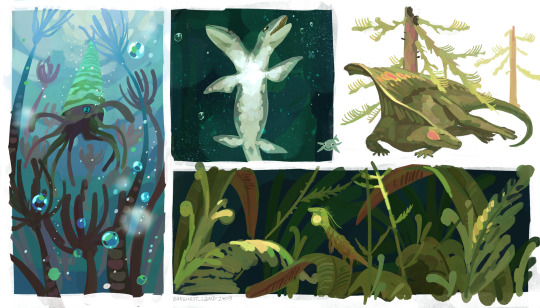
wanted to go green today 20min sketches from flocking again: menacingly floating cameroceras, unlucky baby thalassotitan (you can find a lucky one in the corner), ctenosauriscus vibing under some trees and... a little saltopus. just standing there.
#it's 4am goodnight i drew all this being halfway asleep#but i wanted to at least do some stupid sketches#drawing a lot of difficult and high detailed stuff at work rn#i need REST#barghestland#art#artists on tumblr#paleoart#paleoland#paleostream flocking#cameroceras#thalassotitan#ctenosauriscus#saltopus
898 notes
·
View notes
Text
#Paleostream 14/09/2024
here's today's #Paleostream sketches!!!
today we drew Cameroceras, Thalassotitan, Ctenosauriscus, and Saltopus. not my strongest recent flocking im ngl, very happy with the Thalassotitan though




#Paleostream#paleoart#paleontology#digital art#artists on tumblr#digital artwork#palaeoart#digital illustration#sciart#id in alt text#cephalopod#Cameroceras#crinoid#sea lily#marine reptile#mosasaur#mosasaurid#Thalassotitan#turtle#sea turtle#archosaur#triassic#archosaurs#Ctenosauriscus#Saltopus#paleoblr#palaeoblr#sketch#sketches
151 notes
·
View notes
Text
Results from yesterday’s flocking paleostream

yesterday was SO FUCKING GOOD!!!! We did cameroceras,

Thalassotitan,

Ctenosauriscus, (he has blimd eye)

And the teeny tiny mouse lizard, Saltopus
also I have escaped the vat of hammers and am nom stuck under your floors :3
#paleoart#lmao#art#paleontology#i am in your walls#vat of hammers#inside joke#paleoblr#paleostream#flocking#flocking paleostream#what the flock#:3#cameroceras#thalassotitan#Ctenosauriscus#Saltopus#dinosauromorph#poposauroid#poposaur#pseudosuchia#nautiloid#mosasaur#lizard#rodent#insect#sciart#artists on tumblr
94 notes
·
View notes
Text



An early Triassic diorama starring Ctenosauriscus.
4 notes
·
View notes
Text




Results from the Flocking #paleostream!
Cameroceras, Thalassotitan, Ctenosauriscus and Saltopus.
493 notes
·
View notes
Text




Doodles from yesterday's Flocking Paleostream featuring Cameroceras, Thalassotitan, Ctenosauriscus, and Saltopus.
186 notes
·
View notes
Text


DISGUISAUR (grass-dragon)
If there was ever a pokemon self-aware of its own shortcomings, it'd be Disguisaur. A thoroughly average sort of 'mon with little discernable elemental power, no powerful evolution or anything beyond what it has on hand. Which is unfortunate as they tend to live in jungles populated with only the fiercest,toughest pokemon in the entire region! What disguisaur does have however is a cunning,if neurotic mind and often it's all it really needs...
Using the resources of its forested home,branches,bark, slate pebbles and fruit husks with a helping of sticky mud to bind it all together Disguisaur creates elaborate costumes to ward off other pokemon . Funnily enough the rise in the pokemons confidence wearing said disguises brings can in turn lead to a rise in specific stats based upon the disguise worn, a horned or spiked disguise meant to ward off a potential predator leads to a boost in defensive stats for example, whilst a disguise meant to scare potential competitors off of some food yields a boost in attack stats.
If training a Disguisaur, these factors are of primary importance as is improving the animals confidence in its abilities both in regards to and beyond its disguises, as well as encouraging its creativity during their creation. Some trainers have taken to enrolling their Disguisaurs in "forest-school"-type activities to better said skills,and if taught well the pokemon is known to be a fierce,intelligent battler and loyal companion.
Back again with another pokemon (based on Triassic Archisauriform reptiles) and one of the personal favourites of I've designed so far,wdyt?
Design inspiration down below:
Disguisaur is based on the various strange and diverse archisauriform reptiles that proliferated between the end-permian and end-triassic extinction events before the dinosaurs.
The HP disguise is based on the sailed Ctenosauriscus.

The Attack disguise is based on the large-headed Erythrosuchus.

The Defense disguise is based on the horned Shringasaurus.

The Special Attack disguise is based on the crocodile-like Smilosuchus.

The Special Defence disguise is based on the armoured Desmatosuchus.

The Speed disguise (or lack thereof) is based on the early archisauriforms found in the fremouw formation in Antarctica

See along with New Zealand/Aotearoa and the various islands of the South Pacific, I intend on including a sort of tropical "lost world" area far to the south of the region shrouded in nigh impenetrable glaciers and mountains based on the Ross territory of Antarctica claimed by New Zealand/Aotearoa, which is rich in Permian,Triassic and Jurassic fossils since the south pacifics fossil record is a little on the scrappy side and I feel I needed a few more creatures for pokemon inspiration.
Anyways,watch this space because I'm in the mood for drawing creatures and further filling out the pokedex of this as yet still unnamed region,who knows I might do some regional variants next...
6 notes
·
View notes
Text

Image: comment by @erinsintra-ramblings asking "What is a pseudosuchian dragon? Forgive my stupidity lol"
No worries, no one talks about pseudosuchians so it's not a stupid question! Pseudosuchians are a group of animals that I am basing my dragon designs on. Pseudosuchians, dinosaurs and pterosaurs make up the group 'archosauria', so you could see pseudosuchians as cousins-to-dinosaurs. Dinosaurs are very popular and well known, pterosaurs are nearly as well known as dinosaurs, while pseudosuchians are talked about less.
While the last surviving dinosaurs evolved into birds, the last surviving pseudosuchians evolved into crocodiles. Pseudosuchia includes crocodiles, crocodylians, crocodylomorphs, paracrocodylomorphs and more! There were bipedal nimble pseudosuchians like Shuvosaurus and Effigia, armoured plant eaters like Desmatosuchus and Aetosaurus, pseudosuchians with sails on their backs like Arizonasaurus and Ctenosauriscus, and even ocean-dwelling sea monsters like Dakosaurus (I am partial to the ocean crocs or thalattosuchians as I have studied them professionally). There was a lot of pseudosuchian diversity beyond just crocodiles!
As I am a huge pseudosuchian fan, my creative project about dragons has made dragons evolve from pseudosuchians, so in the world of Dracones Mundi the surviving pseudosuchians are crocodiles AND dragons, so my dragons are like cousins-to-crocodiles. I keep some croc features like osteoderms and crocodile behaviours, and then I give my dragons some very un-croc features like venom and the ability to fly by magic. By and large, my dragons are based on crocodile relatives as dragons are often large reptles who live in water in mythology, which is what crocodiles do!
Thank you for the question! :3
Lots of new followers!
I've been working on this project offline a lot, I should really talk more on this blog
Anyone got questions on pseudosuchian dragons? What sort of posts do people want to see?
19 notes
·
View notes
Photo

So this past week was Triassic Weirdos week for my $2 patrons over on Patreon! I made little posts about eight of my favorite creatures from the Triassic, since I only talked about the late Triassic in the Earth Before Us book and the early Triassic was so chock full of fun critters.
Also, Shringasaurus was described a couple weeks ago, and I love the Crystal Palace vibes that thing gives off. I had to draw it!
#patreon#not dinosaurs#triassic weirdos#from top left:#icarosaurus#ctenosauriscus#drepanosaurus#atopodentatus#sharovipteryx#shringasaurus#tanystropheus#longisquama
244 notes
·
View notes
Text
cypressure 2024 top 10
1. Kentrosaurus aethiopicus - 8,095 notes - Jul 10 2024

2. amtrak cascades - 3,758 notes - Sep 19 2024

3. Irritator challengeri - 2,347 notes - May 14 2024

4. Sauropelta - 2,075 notes - May 4 2024
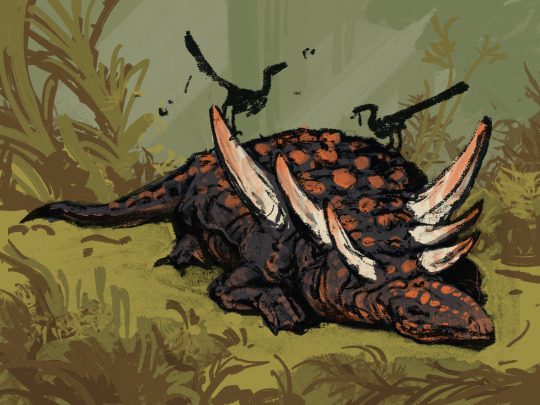
5. Fona, Isotelus, Coahuilasaurus, and Goyacephale - 1,760 notes - Sep 8 2024

6. izzy + tem - 1,524 notes - Jan 27 2024

7. Raptor Red - 1,498 notes - Mar 30 2024
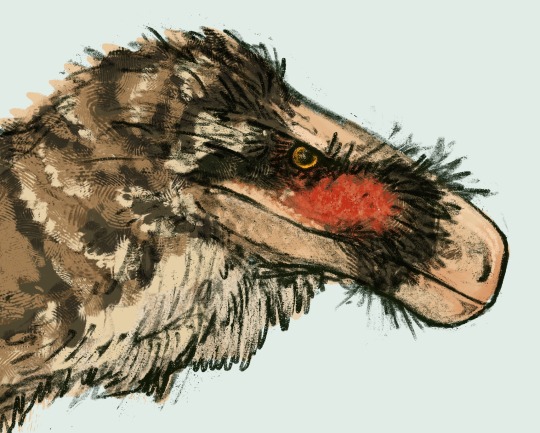
8. Dilophosaurus - 1,427 notes - May 20 2024

9. Opabinia, Barosaurus, Titanites, and Saurornitholestes - 1,345 notes - Sep 21 2024

10. Cameroceras, Thalassotitan, Ctenosauriscus, and Saltopus - 1,317 notes - Sep 15 2024

Created by TumblrTop10
74 notes
·
View notes
Text
Mastodonsaurus

By Tas Dixon
Etymology: Nipple-toothed reptile
First Described By: Jaeger, 1828
Classification: Biota, Archaea, Proteoarchaeota, Asgardarchaeota, Eukaryota, Neokaryota, Scotokaryota Opimoda, Podiata, Amorphea, Obazoa, Opisthokonta, Holozoa, Filozoa, Choanozoa, Animalia, Eumetazoa, Parahoxozoa, Bilateria, Nephrozoa, Deuterostomia, Chordata, Olfactores, Vertebrata, Craniata, Gnathostomata, Eugnathostomata, Osteichthyes, Sarcopterygii, Rhipidistia, Tetrapodomorpha, Eotetrapodiformes, Elpistostegalia, Stegocephalia, Tetrapoda, Temnospondyli, Limnarchia, Stereospondylomorpha, Stereospondyli, Capitosauria, Mastodonsauridae
Referred Species: M. jaegeri, M. cappalensis, M. giganteus, M. torvus
Status: Extinct
Time and Place: 247 to 237 million years ago, from the Anisian to the Ladinian of the Middle Triassic
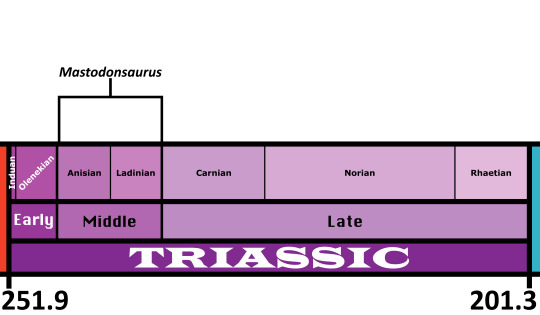
Mastodonsaurus is known mostly from Germany and Russia.

Physical Description: Mastodonsaurus was a very large temnospondyl, growing up to 6 meters (20 feet) long. It’s one of the largest “amphibians” (if you accept the term to mean non-amniote tetrapods) known from actually decent remains. This thing’s downright badass. Its head was large, wide and flattened, with the eyes positioned at the top about ⅔ of the way back. The head was roughly-textured, being covered in rugosities that suggest a tight covering of skin. The upper and lower jaws were filled with spikelike teeth, of which there were two rows in the upper jaw. Each tooth has a complex labyrinthine structure in cross section, leading to the colloquialism “labyrinthodont” for big temnospondyls like this. Two teeth in the front of the lower jaw had developed into large tusks, which were so large that there are holes on the top of the jaw for the tusks to go through when the mouth was closed. I repeat: IT HAD HOLES IN ITS SKULL BECAUSE ITS TEETH WERE SO BIG. That’s downright gnarly. The upper jaw also had enlarged fanglike teeth on the palate, but they weren’t that huge. Postcranially Mastodonsaurus was similar to other temnospondyls, with short, sprawling limbs and a powerful tail.
Diet: Mastodonsaurus’s diet likely consisted of any living or until-recently-living animal that happened to be in the water (including if it was pulled in).
Behavior: Mastodonsaurus likely lived similarly to modern crocodiles, lurking in waterways waiting for prey. In the water it may have done short chases after prey such as fish and other temnospondyls, but it probably ambushed tetrapod prey. Its limbs were quite small relative to the rest of its body, indicating that it likely spent most of, or even almost all of, its time in the water. It may have been able to attack animals on the banks of waterways, but that’s probably the most it did on a regular basis: grabbing prey on the shore of the water and dragging it back in to be eaten.
Ecosystem: Mastodonsaurus lived in environments with lots of freshwater. Some Mastodonsaurus-preserving environments also bear marine fossils, suggesting it may have also lived in coastal deltas or estuaries. M. jaegeri, M. cappalensis and M. giganteus lived in what is now west-central Europe. This area was evidently very wet, as evidenced by the variety of aquatic animals discovered there. These include fellow temnospondyl Gerrothorax, the nothosaurs Nothosaurus and Simosaurus, the early turtle Pappochelys, Tanystropheus, sharks, mollusks, and our old friends Ceratodus and Saurichthys. Some terrestrial animals also lived in this area, like cynodonts and the pseudosuchians Batrachotomus and Ctenosauriscus. Meanwhile, M. torvus lived in what is now Russia, alongside fellow temnospondyls Plagioscutum and Plagiorotus, the prolacertid Malutinisuchus, the rauisuchid Energosuchus, the erythrosuchid Chalishevia, and Elephantosaurus, a dicynodont with a horrible name.
Other: I try not to be an awesomebro, but this thing was pretty cool.
~ By Henry Thomas
Sources under the cut
Moser, M., Schoch, R. 2007. Revision of the type material and nomenclature of Mastodonsaurus giganteus (Jaeger) (Temnospondyli) from the Middle Triassic of Germany. Palaeontology 50(5): 1245-1266.
Owen, R. 1842. On the Teeth of Species of the Genus Labyrinthodon (Mastodonsaurus of Jaeger), common to the German Keuper formation and the Lower Sandstone of Warwick and Leamington. Transactions of the Geological Society of London 2(5). 503-513.
Schoch, R.R. 1999. Comparative osteology of Mastodonsaurus giganteus (JAEGER, 1828) from the Middle Triassic (Lettenkeuper: Longobardian) of Germany (Baden-Wurttemberg, Bayern, Thuringen). Stuttgarter Beitrage zur Naturkunde B 278: 1-175.
#mastodonsaurus#temnospondyl#labyrinthodont#triassic#triassic madness#triassic march madness#prehistoric life#paleontology
298 notes
·
View notes
Note
So how about them pre human crocodiles? Were they too so very good at pretending to be logs?
!!!! I AM CERTAINLY NO LOG PRETENDER!

(art by Nobu Tomura - http://spinops.blogspot.co.uk/ )
Nor is my spiky aetosaur friend!


(Credit to Dr Jeff Martz, then Tomura again)
Postosuchus might look like a log, if logs looked angry!

(my cousin postosuchus is actually lovely)
Do logs have sails on their backs? if so, I guess Arizonasaurus does sterling work pretending to be a log:

(Tomurrrrra art credit again, thank you for drawing all the psuedosuchians for wikipedia!)
Look! Another log! Oh wait, it’s Ctenosauriscus!

I don’t know what the logs are like from where you are from but if they look like Prestosuchus then sure, she’s a log as well

(art by Dmitry Bogdanov, who also does a lot of psuedosuchian art for wikipedia)
Ah yes another log:

(Thanks Dr Jeff Martz)
But okay, you are asking about crocodiles, not the rest of us psuedosuchians.
So… do the crocodiles pretend to be logs?
Yes.
Very

Very

Big Logs
(Art by Raul Martin)
-MOD SHUVO
69 notes
·
View notes
Text
The Long, Strange Tale of the Hand Beast Footprints
https://sciencespies.com/nature/the-long-strange-tale-of-the-hand-beast-footprints/
The Long, Strange Tale of the Hand Beast Footprints

In Arthur Conan Doyle’s A Study in Scarlet, the legendary sleuth Sherlock Holmes observes: “There is no branch of detective science which is so important and so much neglected as the art of tracing footsteps. Happily, I have laid great stress upon it, and much practice has made it second nature to me.”
Holmes is able to distinguish the separate tracks of two men from the many footmarks of the constables on the scene. He can calculate when the men arrived, and by the length of their stride, can determine their height. He also determines that one man is fashionably dressed “from the small and elegant impression left by his boots.”
Countless crime scene investigators have used footprints to apprehend culprits, but footprints are also a valuable resource for studying ancient animals. In many rock formations, tracks are the only remaining record that paleontologists can find of animals that lived millions of years ago.
We can identify the creatures who made fossil footprints if the imprints are well-preserved. The details in these will often reveal the configuration of the bones in the hands or feet and even show traces of skin on the palms and soles. From the length of the stride, researchers can also calculate the speed at which the animal moved.
Sometimes, however, the shape of the footprints can be misleading. Take for example, a set of footprints found in 1833, in a small town in Germany. The fossil footprints, discovered during a construction project, confounded the great naturalists of the day. And, therein lies a tale.

The peculiar foot prints of the hand beast showed hind feet imprints that looked like large human hands with prominent thumbs alongside much smaller front feet.
(Hans-Dieter Sues)
More
Friedrich Sickler, the high-school principal in the town of Hildburghausen, first discovered the fossils. He was building a garden house when he noticed strange imprints on the sandstone slabs that were used for this construction project. The sediment was part of what today is termed the Buntsandstein, meaning “colored sandstone,” which represents the early part of the Triassic Period in much of Europe—about 252 to 248 million years before the present.
Sickler offered rewards for more tracks to the workers in the sandstone quarry and soon a large surface covered with the footprints was exposed. The hind feet imprints looked like large human hands with prominent thumbs. The much smaller front feet left only imprints of the fingers. Unable to identify the maker of these tracks, Sickler published an “open letter” in 1834 describing his discovery to the famous German physician and naturalist Johann Friedrich Blumenbach.
Word of Sickler’s find quickly spread and many naturalists weighed in with interpretations of the track maker. Europe’s natural history museums rushed to acquire track-bearing slabs cut from the quarry’s sandstone surface. Researchers made learned guesses at what sort of creature could have left the tracks. The legendary explorer Alexander von Humboldt believed that they were made by a marsupial. Another naturalist insisted the prints were the tracks of a giant ape and still others offered up animals as varied as giant toads and bears. Finally, the German naturalist Johan Kaup named the unknown creature Chirotherium, which means simply “hand beast” in Greek.
A few years after Sickler’s discovery, Chirotherium tracks were found in Cheshire, England, and later also in France and Spain. Naturalists remained at a loss. The unusual footprints were turning up in other locations but without any known skeletal remains of backboned animals to help identify what could have left them.

Recently restored reconstructions for one contender, the giant toad-like Labyrinthodon, can still be found in Sydenham, London.
( Tom Page, Wikimedia Commons)
More
In the 1840s, two famous Victorian scientists, Sir Richard Owen and Sir Charles Lyell, developed theories about the animal responsible for the Chirotherium footprints.
From rocks in Warwickshire, Owen identified a few bones similar in age to those from Cheshire as belonging to large amphibian precursors. He named these animals Labyrinthodon because of the labyrinthine folding of the dentine in their teeth. Owen surmised that Labyrinthodon could have made the tracks of Chirotherium. A few years later, Owen began working with the British artist Benjamin Waterhouse Hawkins to build the first life-sized reconstructions of prehistoric animals for the Great Exhibition of 1851 in London. (The models, recently restored, are still on view in a park in Sydenham, London.) The two men envisaged Labyrinthodon as a giant toad-like creature that looked like it had escaped from the nightmarish paintings of Hieronymus Bosch.
Lyell, who is considered the father of modern geology, meanwhile, wondered how the Chirotherium would have ambulated because the “thumbs” of the tracks were pointed to the outside of the foot. Using the Owen-Hawkins model of Labyrinthodon, Lyell surmised that the animal must have walked with its feet crossed! Other researchers found Lyell’s reconstruction implausible, but they could do no better.

In 1855, Sir Charles Lyell took a stab at modeling how Chirotherium might have walked, surmising that because of the thumbs, the poor creature had to get around with its feet crossed.
(Hans-Dieter Sues)
More
Little changed until 1925. That’s when a German paleontologist named Wolfgang Soergel decided to review all available specimens of Chirotherium held in German collections.
Looking at the feet of many living reptiles, he realized that the “thumb” had been misidentified because previous researchers had been so heavily influenced by its similarity to a human thumb. It was, in fact, Soergel pointed out, the fifth toe sticking out from a five-toed hind foot. Measuring the trackways, Soergel, then, reconstructed the limb posture and proportions of the Chirotherium track-maker. In Soergel’s model, the creature would have had strong hind legs and short forelegs, both of which were held much more upright than in living reptiles. The hind feet left large impressions whereas the front feet barely touched the ground. Much like our fingers and toes, well-preserved footprints had distinct crease lines, which allowed Soergel to reconstruct the arrangement of bones in the digits.
But the question still remained: what animal left the Chirotherium footprints?
After an extensive search, Soergel noted that a two-foot-long reptile named Euparkeria roaming South Africa early in the Triassic also had a foot with its fifth toe sticking out to the side. Euparkeria is an ancient precursor of both crocodilians and dinosaurs. Although the reptile that made the Chirotherium tracks was quite a bit larger than little Euparkeria, Soergel inferred that the Chirotherium track-maker was probably related to the South African reptile.
Enter the famous German paleontologist Friedrich von Huene, who in the late 1920s was conducting fieldwork in the Brazilian state of Rio Grande do Sul. A German doctor had sent him crates of unusual bones found there and dating from the Triassic. While in Brazil, Huene became acquainted with a local resident named Vincentino Presto, who knew of a promising deposit of such bones. In 1942, Huene recovered the remains of a large predatory reptile that he christened in honor of Presto, Prestosuchus. This creature attained a length of at least 20 feet and is distantly related to crocodilians.

Batrachotomus is a slightly younger relative of Ticinosuchus. It has the same foot structure with a spread-out fifth toe that created the “thumb” imprint of Chirotherium.
( Staatliches Museum für Naturkunde Stuttgart, Wikimedia Commons)
More
When Huene reassembled its foot bones he noted a striking resemblance to the foot skeleton that Soergel had reconstructed for the maker of Chirotherium. Huene had come across a major clue about the track-maker. The Chirotherium tracks were probably left by a reptile related to Prestosuchus.
However, at that time, nothing like Prestosuchus had ever been recognized in Europe and other scientists remained unconvinced by Huene’s interpretation.
It was decades later, in 1965 that another major clue emerged, when the French paleontologist Bernard Krebs described the nearly complete skeleton of a ten-foot-long crocodile relative found in Triassic rocks of the Ticino region in Switzerland. Krebs named his creature Ticinosuchus, Latin for “crocodile from the Ticino,” noting that its feet were near-perfect matches to the Chirotherium footprints and its body form closely matched Soergel’s reconstruction. Furthermore, the rocks containing the remains of Ticinosuchus were the same geological age as those with Chirotherium. It was a promising connection.
Meanwhile in 2004, the town of Hildburghausen, looking for its rightful place in history, dedicated a monument to the decades-long long search for the track-maker. It featured the reconstructed original sandstone surface with the Chirotherium tracks but the bronze reconstruction of a crocodile-like reptile was still not quite accurate.
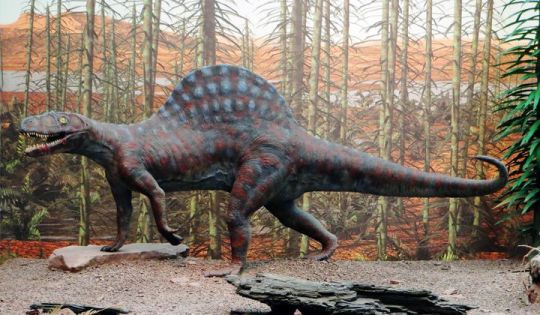
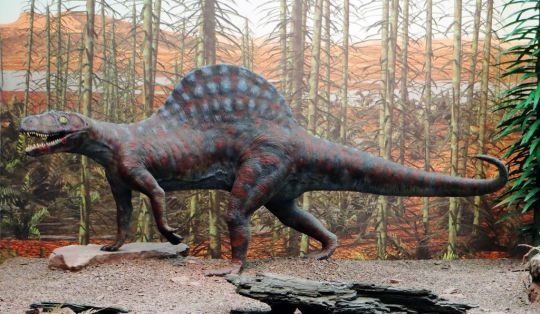

After decades, researchers finally found the culprit. It was Ctenosauriscus, (reconstruction above) which had very tall spines on its backbone that probably supported a sail.
(Hans-Dieter Sues)
More
There was one last chapter in this long saga. It involved another reptile—Ctenosauriscus, which is Greek for “comb reptile,” and was from the Buntsandstein of Germany. Very tall spines on its backbone probably supported a sail along the back of the animal. The 2005 publication of a skeleton of the closely related Arizonasaurus in the Moenkopi Formation of Arizona established that the German Ctenosauriscus belonged to the same group of crocodile-like reptiles as Prestosuchus and Ticinosuchus. The Moenkopi Formation is nearly the same geological age as the German Buntsandstein and has also yielded many footprints of Chirotherium.
Now at long last, the Holmesian quest for the maker of the Chirotherium footprints has come to an end. It was crocodile precursors like Arizonasaurus, Ctenosauriscus, Prestosuchus and Ticinosuchus, that had left these prints.
Tracks that resemble those of Chirotherium have now been found on most continents. Some possibly represent precursors of dinosaurs. Many other kinds of fossil footprints have been found, hinting at the existence of as-yet-unknown animals awaiting future discovery. As Sherlock Holmes would have said: “The game is afoot.”
Join us on Facebook or Twitter for a regular update.
#Nature
0 notes
Text
I was curious because I'd never seen a Ctenosauriscus before so I did the old googlin and

DEMON! BE GONE!

Bruh why is this nut always the first damn result, it and that reptile one (Which, funny enough, is in the second row of the 'images' on search) oiiiii. Remember kids, stay away from 'Pterosaur Heresies' and Reptile Evolution.




Results from the Flocking #paleostream!
Cameroceras, Thalassotitan, Ctenosauriscus and Saltopus.
493 notes
·
View notes
Note
well tbh Ctenosauriscus cold pass as a log in my corner of the world. you see the ocean here, the baltic sea, has aggresive Cyanobacteria bloomings during summer. well then everything looks slimy and green. and tbh everything cold be log. like thanks cyanobacteria for giving us air to breath etc etc. but chill with these shenigans in the baltic sea (this is a human pollution created problem. this is not normal for baltic sea)
Next time I hear my cousin complaining that she doesn’t look enough like a log I shall tell them where True Logginess can be achieved.
I don’t know if the Baltic Sea might be a little chilly for us; I mean, because we are huge-bodied archosaurs we are a little better at controlling our temperatures than mere lizards, so maybe your sea is a log-mimic’s paradise.
-Mod Shuvo
#Mod Shuvosaurus#Ask#I tried looking up what was happening in the Baltic Sea in the late Triassic#But sadly in this era we have few atlasses or countries to speak of#I'll ask around my psuedosuchian family to see who lives in this area#I am aware of other asks about this place#But the climate was different back in the late Triassic
5 notes
·
View notes